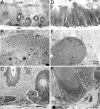Plant cyclotides disrupt epithelial cells in the midgut of lepidopteran larvae
- PMID: 18202177
- PMCID: PMC2234119
- DOI: 10.1073/pnas.0710338104
Plant cyclotides disrupt epithelial cells in the midgut of lepidopteran larvae
Abstract
Several members of the Rubiaceae and Violaceae plant families produce a series of cyclotides or macrocyclic peptides of 28-37 aa with an embedded cystine knot. The cyclic peptide backbone together with the knotted and strongly braced structure confers exceptional chemical and biological stability that has attracted attention for potential pharmaceutical applications. Cyclotides display a diverse range of biological activities, such as uterotonic action, anti-HIV activity, and neurotensin antagonism. In plants, their primary role is probably protection from insect attack. Ingestion of the cyclotide kalata B1 severely retards the growth of larvae from the Lepidopteran species Helicoverpa armigera. We examined the gut of these larvae after consumption of kalata B1 by light, scanning, and transmission electron microscopy. We established that kalata B1 induces disruption of the microvilli, blebbing, swelling, and ultimately rupture of the cells of the gut epithelium. The histology of this response is similar to the response of H. armigera larvae to the Bacillus thuringiensis delta-endotoxin, which is widely used to control these insect pests of crops such as cotton.
Conflict of interest statement
The authors declare no conflict of interest.
Figures






References
-
- Craik DJ, Daly NL, Bond T, Waine C. J Mol Biol. 1999;294:1327–1336. - PubMed
-
- Craik DJ, Cemazar M, Wang CK, Daly NL. Biopolymers. 2006;84:250–266. - PubMed
-
- Saether O, et al. Biochemistry. 1995;34:4147–4158. - PubMed
-
- Colgrave ML, Craik DJ. Biochemistry. 2004;43:5965–5975. - PubMed
-
- Craik DJ. Science. 2006;311:1563–1564. - PubMed
Publication types
MeSH terms
Substances
LinkOut - more resources
Full Text Sources
Other Literature Sources

